Intel Dual Core Performance Preview Part II: A Deeper Look
by Anand Lal Shimpi on April 6, 2005 12:23 PM EST- Posted in
- CPUs
Business Application Performance
Business Winstone 2004
Business Winstone 2004 tests the following applications in various usage scenarios:
- Microsoft Access 2002
- Microsoft Excel 2002
- Microsoft FrontPage 2002
- Microsoft Outlook 2002
- Microsoft PowerPoint 2002
- Microsoft Project 2002
- Microsoft Word 2002
- Norton AntiVirus Professional Edition 2003
- WinZip 8.1
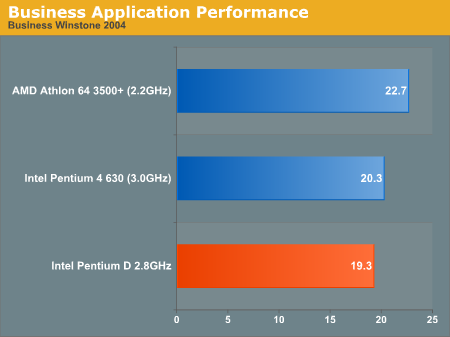
The Pentium 4 and Pentium D perform quite similarly here, but the Athlon 64 3500+ is obviously the strongest performer out of the three when it comes to single threaded business applications.
Office Productivity SYSMark 2004
SYSMark's Office Productivity suite consists of three tests, the first of which is the Communication test. The Communication test consists of the following:
"The user receives an email in Outlook 2002 that contains a collection of documents in a zip file. The user reviews his email and updates his calendar while VirusScan 7.0 scans the system. The corporate web site is viewed in Internet Explorer 6.0. Finally, Internet Explorer is used to look at samples of the web pages and documents created during the scenario."

The next test is Document Creation performance:
"The user edits the document using Word 2002. He transcribes an audio file into a document using Dragon NaturallySpeaking 6. Once the document has all the necessary pieces in place, the user changes it into a portable format for easy and secure distribution using Acrobat 5.0.5. The user creates a marketing presentation in PowerPoint 2002 and adds elements to a slide show template."
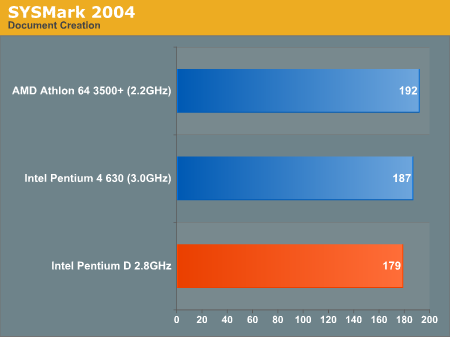
The final test in our Office Productivity suite is Data Analysis, which BAPCo describes as:
"The user opens a database using Access 2002 and runs some queries. A collection of documents are archived using WinZip 8.1. The queries' results are imported into a spreadsheet using Excel 2002 and are used to generate graphical charts."
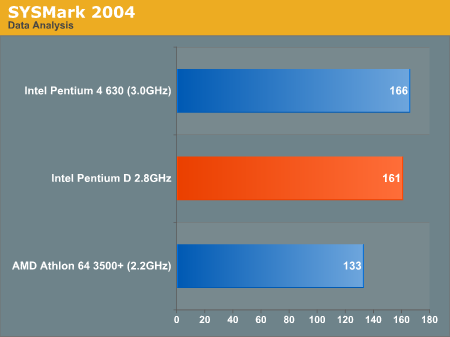
SYSMark paints a much more evenly matched picture between AMD and Intel in the Office Productivity suite. What's interesting is that even AMD recommends SYSMark 2004 as the best overall system performance test for multi-core desktop CPUs.
Business Winstone 2004 includes a multitasking test as a part of its suite, which does the following:
"This test uses the same applications as the Business Winstone test, but runs some of them in the background. The test has three segments: in the first, files copy in the background while the script runs Microsoft Outlook and Internet Explorer in the foreground. The script waits for both foreground and background tasks to complete before starting the second segment. In that segment, Excel and Word operations run in the foreground while WinZip archives in the background. The script waits for both foreground and background tasks to complete before starting the third segment. In that segment, Norton AntiVirus runs a virus check in the background while Microsoft Excel, Microsoft Project, Microsoft Access, Microsoft PowerPoint, Microsoft FrontPage, and WinZip operations run in the foreground."
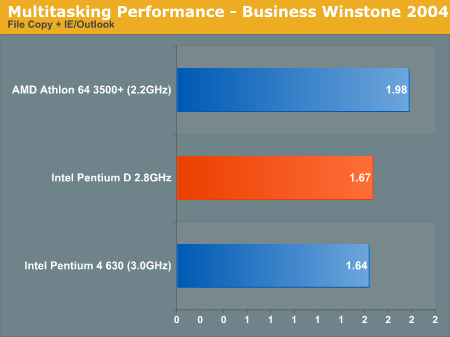
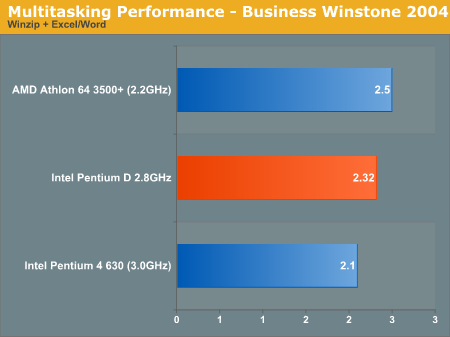
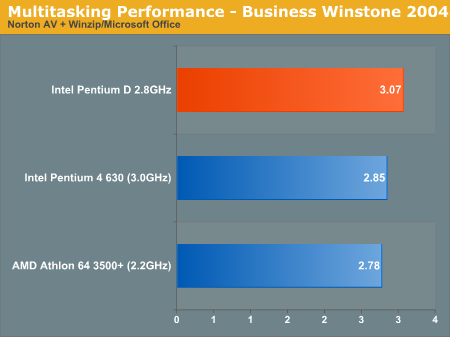
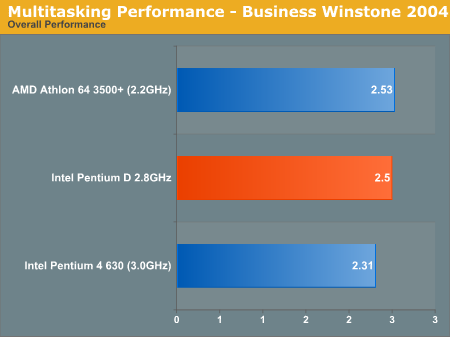
The multitasking tests show the Pentium D 2.8GHz and the Athlon 64 3500+ as equal competitors, with AMD winning the first two tests and Intel winning the last. This just goes to show you that not all multitasking will be immediately faster on a dual core chip.










106 Comments
View All Comments
justly - Thursday, April 7, 2005 - link
#84 What do you consider "very soon"?
The following was quoted from "part 1".
"Make no mistake, Intel isn't officially releasing their dual core desktop processors today; this is merely a preview. Intel's dual core line is still on track to be released sometime in the April - June timeframe."
IF it where to be released in April then there should have been more reviews (sorry, previews).
IF it comes out in May then there is no need to do a preview this early (except to gain marketing hype).
IF it comes out in June then a "preview" this early should have contained technical information about the chip with a "review" containing benchmarks at a later date closer to its release date.
jojo4u - Thursday, April 7, 2005 - link
Was Cool'n'Quiet enabled at the power draw test?fitten - Thursday, April 7, 2005 - link
#81, Intel publicly stated that implementing HT on the P4 was about a 5% increase in logic/area on the chip. While it may be "ugly" and such, 5% certainly isn't that much of area when you consider how much area other functionality takes up.#82, I haven't seen anyone announce duel core products. Dual core products, however, should be out very soon from Intel (and are [p]reviewed in the article this discussion is attached) for example). ;)
Kagjes - Thursday, April 7, 2005 - link
I must say i really can't relate to any of these multitasking scenorios. Well, except the teamspeak-gaming part.What would be most interesting for me is dual-core, dual monitor setup. That would ROCK, and i'm really suprised noone remembered that. For instance, playing a divx on 1 monitor while gaming on other. Or watching TV on 1 while gaming on other (i do that a lot, if the football match is boring). These tasks are pretty much repeatable and can be measured. I was thinking about getting another monitor for these kind of purposes, but i'm not sure on how would my comp react to that kind of stress.
justly - Thursday, April 7, 2005 - link
My personal thoughts about publishing an article on a duel core that is not yet availabile, nor will be for awhile, is that it is strictly marketing hype similar to what happened with the 1.13 GHz P3 or any other product that we the consumer have to wait for.The idea that duel core would have a benifit in multitasking or multithreaded apps could have easily been demonstrated on a multiprocessor system using Opterons or Xeons. So now we get a review full of new (wow factor) benchmarks describing the new found benifit of having two processors working together.
I have no real problem with "preview" style articles, but having a plethora of benchmaks in a "preview" is pointless unless the goal is to advertise (hype) a product. The only people I see having any use for this "perview" are the ones that desperately want proof that their manufacturer of choice (this time being Intel) is superior, or those people who are so fickle that they will support the newest thing on the block no matter if it is needed, affordable or even the best option at the time it becomes available.
Quanticles - Thursday, April 7, 2005 - link
Ive heard that HT is very ugly to impliment, you have to tear everything up. I'm not sure HT is very useful when you have dual core anyway.fitten - Thursday, April 7, 2005 - link
#47, if HT is simply a "bandaid", then why is AMD the only major CPU vendor not using it? IBM uses it heavily in their Power5, Sun is making their next CPUs (Niagra) very highly SMT (same thing as HT). Arguably, both of those architectures have much more shallow pipelines than the P4, yet see reason to provide SMT. AMD is the only holdout.dougSF30 - Thursday, April 7, 2005 - link
Make that 2.4GHz in Q3 (not Q4) for the DC Opti 2.4GHz.dougSF30 - Thursday, April 7, 2005 - link
DC A64 samples are at 2.4GHz, not 2.2GHz.DC Opteron is supposedly launching at up to 2.2GHz in a couple weeks, and will be available at 2.4GHz in Q4.
DC Opteron fits in 95W TDP, DC A64 gets a 110W TDP.
Both are apparently 2 x 1MB L2, per the Italian site that put the CeBIT-timed article about the DC A64 sample.
dparish - Thursday, April 7, 2005 - link
Great article. I am confused by one piece:From page 8:
Seagate Barracuda 7200.7 NCQ - 25.2 minutes
Seagate Barracuda 7200.7 no NCQ - 33.6 minutes
Western Digital Raptor WD740 - 30.9 minutes
I'm shocked that the WD740 is slower. Isn't this the NCQ enabled 10,000 rpm drive? I would have expected this to beat out the 7200.7 NCQ seagate. Any reason why the WD740 would be slower?
Another point / comment:
Is it possible that DVD Shrink is slower on the AMD's because it has not been compiled / optimized for the AMD? Would this be any different on the 64 bit version of XP if DVD Shrink was compiled for 64 bit? Of course this may be moot as DVD Shrink is not longer being developed by the author.
-Dave